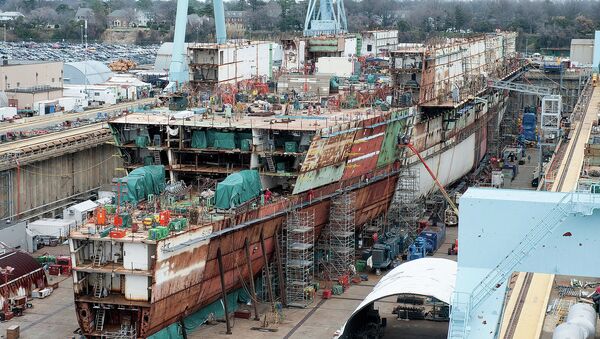Defense One reports that a White House Office of Management and Budget (OMB) document that will soon be released proposes an extensive new shipbuilding plan at the expense of some of the Navy’s future aircraft carriers.
A spokesperson for Russ Vought, director of the OMB, told Defense One, “Our updated 30-year shipbuilding plan is a credible, affordable roadmap for achieving maritime supremacy and sending a strong message to our adversaries like China.”
One official familiar with the plan told Defense One the necessary cuts to the Army and Air Force to make the proposed Navy budget work “are completely unsustainable for any service, and will result in a hollow force if they remain.”
In a Wednesday op-ed in the Wall Street Journal, Vought and White House national security adviser Robert O’Brien defended the Pentagon’s ability to meet the steep demands.
“Assuming a Defense Department budget top line that is effectively frozen at $722 billion in fiscal 2022, adjusted only for inflation, the plan would increase shipbuilding construction by only $6.7 billion, or 33%, to $27 billion in the first year. The Navy buildup would add an additional $39 billion by 2026. Other national-security priorities would not need to be sacrificed. The increased costs would be fully paid for by reinvesting savings accrued from drawdowns in the Middle East, managing the size of military personnel, and cutting Pentagon overhead,” they wrote.
The OMB proposal would reportedly cut the fifth as-yet unnamed Ford-class, which is expected to enter service in 2036, meaning the Navy would build just four of the new warships: the Ford, already finished but yet to enter service; the USS John F. Kennedy, presently fitting out; the USS Enterprise, scheduled for its keel to be laid in 2022; and the USS Doris Miller, scheduled to begin in 2026. Congress has appropriated funding for all four warships.
According to present service life estimates, if the fifth planned Ford-class carrier were canceled, then in 2040, the Navy would have nine carriers, in 2046 just seven, and even less by the 2050s. Earlier this year, an internal Future Naval Force Study recommended the Navy maintain between eight and 11 carriers.
That study, the results of which former Defense Secretary Mark Esper announced in October, recommended as many as 500 ships by 2045, including at least 140 unmanned warships. The Navy’s present strength is 296 warships, and it has been operating since 2016 based on the goals of a 355-ship Navy by 2030.
As Sputnik has reported, the Navy’s present shipbuilding schedule wouldn’t reach that goal. However, the proposed plan’s $170 billion investment between 2022 and 2026, which would buy 82 manned and 21 unmanned warships, would.
Some of those ships would be from the forthcoming Constellation-class of frigates, the Virginia-class attack submarines and a new nuclear-powered attack submarine class, as well as a new model of aircraft carrier to follow the fourth Ford-class supercarrier.
“The question of whether the Navy should shift at some point from procuring CVNs [nuclear-powered aircraft carriers] like the [Ford] class to procuring smaller and perhaps nonnuclear-powered aircraft carriers has been a recurrent matter of discussion and Navy study over the years, and is currently an active discussion in the Navy,” a Congressional Research Service report published on Wednesday noted.
The Navy has already experimented with the idea somewhat, converting some of its landing helicopter docks into “lightning carriers” loaded down with F-35B Lightning II stealth aircraft instead of their normal allotment of helicopters.
Marine Corps Commandant Gen. David Berger described the “lightning carrier” concept as “the birth of the most lethal, aviation-capable amphibious assault ship to date,” noting the configuration makes the Navy all the more “unpredictable” to its foes.
“You would like to see one of those big decks one time go out with two squadrons of F-35s and next time fully loaded with MV-22s [VTOL helicopters] and another [Marine expeditionary unit] with a 50-50 combo,” Berger said at a February event. “Now that’s how you become unpredictable. How do you defend against that?”

